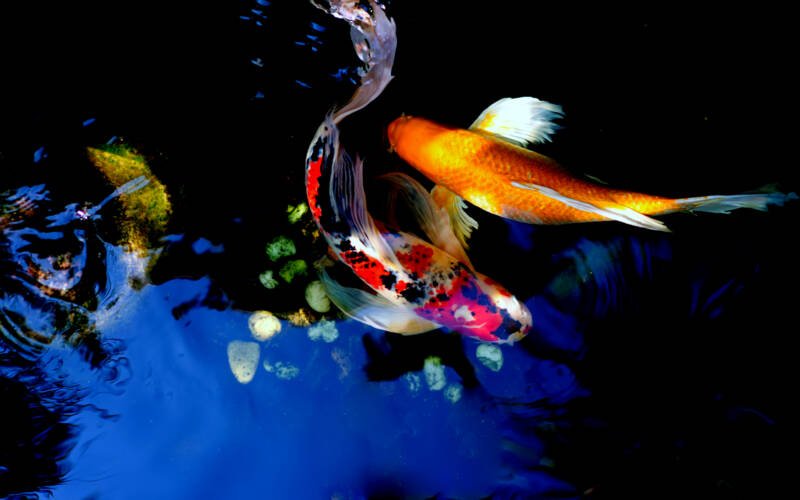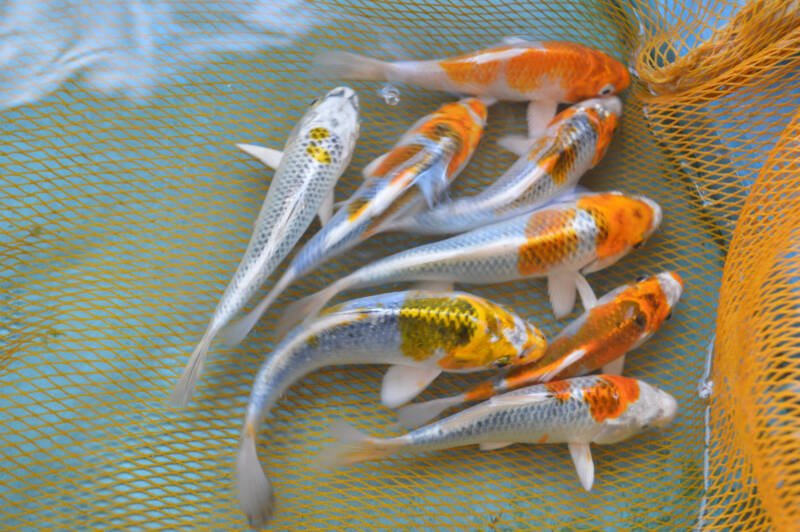Visualize a peaceful koi pond, with its graceful inhabitants gliding effortlessly through the tinted waters.
That image is undoubtedly a popular one when discussing these fish, but there is a more boisterous and turbulent aspect to keeping koi, and that is breeding.
If you keep multiple fish in your pond or home aquarium, chances are at some point, the issue of reproduction will occur.

You might glance into the waters at a plumper than usual koi and wonder: could my koi fish be pregnant?
You might witness your male fish pairing up and roughly bumping your female and wonder: what is going on?
Whether you wish to breed koi or not, this article will touch on key aspects, including signs and behaviors that indicate your pond may become a nursery and how to care for the baby koi.
In this article
Koi Reproduction
First, we will go over koi reproduction. You often hear fish referred to as “pregnant.”
For koi, this is not the case. Koi fish are not livebearers. Instead, they are an egg-scattering species.
In fact, koi fish do not actually mate. The females develop the eggs and deposit them during spawning season. The males then fertilize the eggs externally.
Once the eggs are fertilized, neither parent provides care for the eggs and will even eat them as a convenient source of protein.
A koi’s reproductive time is short when compared to their long lifespan.
Male koi can reproduce once they reach the age of three to five years; females are ready at four to six years old.
Both sexes will be around 10 inches (25 cm) in length when they are of breeding age.
Although the prime reproductive years for a female are when they are between the ages of five to eight, koi can reproduce for six to seven years after reaching sexual maturity.
It takes a female koi fish one year to develop her eggs.
As a result, spawning is an annual event that occurs around springtime. At this time of year, both the weather and water begin to warm.
The environment and potential natural food sources for newly hatched fry are ideal then as well.
Preparing for Breeding: What is the Best Setup?
You have options when it comes to breeding your koi. Either an outdoor pond setup or an indoor tank of at least 200 gallons (757 l) will work.
What is the best setup?
Pond Setup

A pond setup is best if you simply want to observe nature take its course.
This approach results in a limited number of surviving fry.
Koi lay thousands of eggs, and the fish in the pond will devour most of them in a natural culling process.
You can give the surviving fry a fighting chance by adding aquatic plants where they can hide as they grow.
Grow-Out Tank
Another option if you want more surviving fry is to remove the eggs from the pond and transfer them to a grow-out tank.
Hang nylon rope or spawning mops in the pond to create places for the females to deposit eggs and make removing the eggs easy.
Indoor Tank Setup

For an indoor tank setup, plan on a breeding/grow-out tank and, ideally, a hospital tank in which the female can recover after spawning.
You will need quality filtration equipment, air stones, and a sturdy water pump.
If spawning occurs indoors, you need to recreate the effects of springtime, such as lengthening the light cycle and gradually warming the water.
Again, hanging strips of nylon rope or spawning mops creates a tempting place for the females to lay their eggs.
The plus for you is that the eggs are then easy to remove and transfer to a separate tank, if necessary, for hatching and growth of the fry.
Pay attention to the water oxygen levels and make sure they are adequate during the mating and fry development phases. Using an air stone can help with this.
Water Parameters
Regardless of whether you choose an indoor or outdoor setup, the water conditions will be the same.
The key parameters to monitor are temperature and ammonia levels.
To promote spawning, the temperature should be between 65 and 75°F (18 to 24°C).
The ammonia levels should be near zero for the health of the fry.
Keep a quality testing kit on hand to monitor your water. Change out 20 to 30% of the water in your indoor tank regularly to keep it clean.
If you want to avoid a spawning event, you can try to discourage it by keeping the water temperature cool as warmer waters trigger spawning.
Is Your Koi Pregnant?

How can you tell if your female koi fish is carrying eggs?
There are both physical and behavioral indications that your female is gravid and ready to spawn.
Males also exhibit physical and behavioral changes ahead of the event.
Physical Signs
There will be a noticeable swelling in your female’s abdomen if she is carrying eggs.
Sometimes, this swelling can give her a lopsided look.
Males that are ready to spawn develop white spots on their gills and pectoral fins.
Remember that females are of breeding age when they reach three to five years old or around 10 inches (25 cm) in length.
If you notice swelling in a fish that is younger than three years or is less than 10 inches in length, your fish may be sick or have parasites.
A female of breeding age that displays abdominal swelling outside of spawning season may be egg-bound. In this case, she has not reabsorbed her unreleased eggs.
She may also have a cyst if one side of her belly swells abnormally. Seek treatment for both conditions as soon as possible.
Behavioral Indicators
Be on the lookout for behavioral indications that your fish are ready to spawn.
About a month before, females will eat more, and while all the fish are actively swimming around the pond, you may see the males chasing the females, causing them to hide.
Another interesting behavior comes from the males. Look to see if the males are pairing up, cruising the pond, and searching for females.
The males form pairs so that they can bump the female from either side to encourage her to release her eggs.
You may also observe the females cleaning a selected site in preparation for depositing her eggs.
This behavior is ultimately pointless as she will scatter her eggs throughout the habitat. However, it may indicate that a spawning event is near.
Spawning
If the koi are not already kept together, introduce the male to the female in the afternoon hours. Spawning should take place before dawn.
The males’ encouragement of the females to drop their eggs can get boisterous, sometimes resulting in injury to the female.
Keep an eye on interactions as you may need to separate overly enthusiastic males.
The spawning period occurs within a two-to-three-day timeframe. The actual process of spawning lasts about a half-hour.
What do koi eggs look like?

Koi eggs are round, translucent, and a few millimeters in diameter. The eggs readily stick to any surface on which they land.
As the fertilized eggs develop, you will see a brownish “seed-like” shape and the black dots of the fish eyes.
Non-viable eggs will look milky-white. Remove any such eggs promptly as the decay can negatively impact water quality.
Remember that koi fish will eat their own eggs. For the greatest odds of a large batch of healthy fry, collect the eggs and keep them in a separate tank or pond.
Care and Feeding
The eggs should hatch within three days to a week.
At first, the tiny fry will stay with their egg sacs to absorb necessary nutrients.
Over the next two to three days, the koi babies will begin swimming. They cannot swim well at first and will spend a decent amount of time hiding among aquatic plants.
Having your baby koi in a separate habitat provides them with the highest level of safety from becoming a snack for other fish.
Be aware, however, that baby koi can eat other fry that are smaller or weaker than they are.
This is a natural part of the process. Of the thousands of eggs released and fertilized, few will survive to adulthood.
Feed your baby koi fish four to five times a day. Start with liquid fry food, then transition to crushed flake food, baby brine shrimp, or larvae as the fish grow.
Keep the fry in the breeding tank until they are at least three inches in length, which is usually when they are between four to six months old.
At this point, the young fish are large enough that the adult koi cannot eat them, and it is safe to introduce them to the community tank or pond.
Closing Thoughts
Breeding koi fish can be a rewarding experience for those new to keeping koi and veteran keepers alike.
The setup and interaction required by the aquarist are minimal.
The biggest commitment is undoubtedly ensuring adequate space both for the fish to spawn and to raise the fry.
Once you establish the space, feeding your fish adequately and monitoring water quality are vital.
The joy of watching the tiny fry grow into the beautiful species that are koi is worth the effort.
Be aware of the rough nature of the spawning process as well as the natural attrition of koi eggs and fry. While these things can seem alarming, they should not discourage you from trying to breed your koi.
Let us know your thoughts!
How successful have you been in breeding your koi?
Do you prefer a pond or indoor setup?